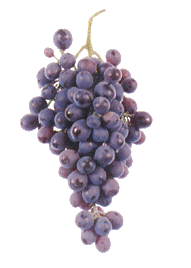 |
| Alvarelhão Grapes |
Today's featured wine is from the Vinho Verde region of Portugal, which we've taken a brief look at before when we talked about the Espadeiro grape. As mentioned in that post, Vinho Verde is a wine region in northern Portugal. Many of the wines that are made there are light, spritzy white wines that are so prevalent that many people think that Vinho Verde refers to that particular style of wine rather than the region, but wines from Vinho Verde come in all different colors and styles, from light spritzy whites to deep brooding reds. Today's wine is somewhere in between. Like the Espadeiro I wrote about previously, this was a rosé wine made from a blend of three different grapes: Alvarelhão, Pedral and Vinhão. Like many Portuguese wines, I can't find any indication either on the bottle or online about how much of the blend each grape makes up, so this wine is the perfect bottle to kick off Weird Blend Wednesday.
 |
| Pedral Grapes |
Pedral is also a red-skinned grape that is grown both in Spain, particularly in Galicia where it is known as Pedral, and Portugal, where it can often be found under the names Padral or Cainho. It's grown mostly in the Monção sub-region of Vinho Verde, where it is one of the recommended varieties for planting, but it may actually be Spanish in origin. It's pretty hard to say. There isn't a whole lot of information out there about this particular grape.
 |
| Vinhão Grapes |
The wine that I tried which was made from these grapes was the 2009 Muralhas de Monção (which means "the walls of Monção") Vinho Verde rosé, which I picked up for about $9. The wine is made by the Adega Coop. Regional de Monção, which is a massive collection of over 1,700 growers who farm about 1,200 total hectares of land spread between the Monção and the Melgaço regions of Vinho Verde. The co-op was established just south of the town of Monção in 1958 and only had about 25 growers at the time. The grapes are hand-harvested and vinified in stainless steel tanks. In the glass, the wine had a medium salmon pink color with just a little bit of effervescence. The nose was fairly aromatic with strawberry and grapefruit with some grapefruit peel and a slight grassy kind of herbaceousness to it. On the palate the wine was on the lighter side of medium with fairly high acidity and just a touch of effervescence. There were bright strawberry and watermelon fruit flavors with a touch of pink grapefruit as well. The wine was simple, fresh and fruity. If you can picture a zippy Sauvignon Blanc mixed with a bright, fruity rosé, that would be a good comparison for what this wine was like. It's a great summer wine that is really hard to beat for the money. Plus, how often do you get to cross off three different grapes from your Wine Century Club application for only $9?

No comments:
Post a Comment
Note: Only a member of this blog may post a comment.